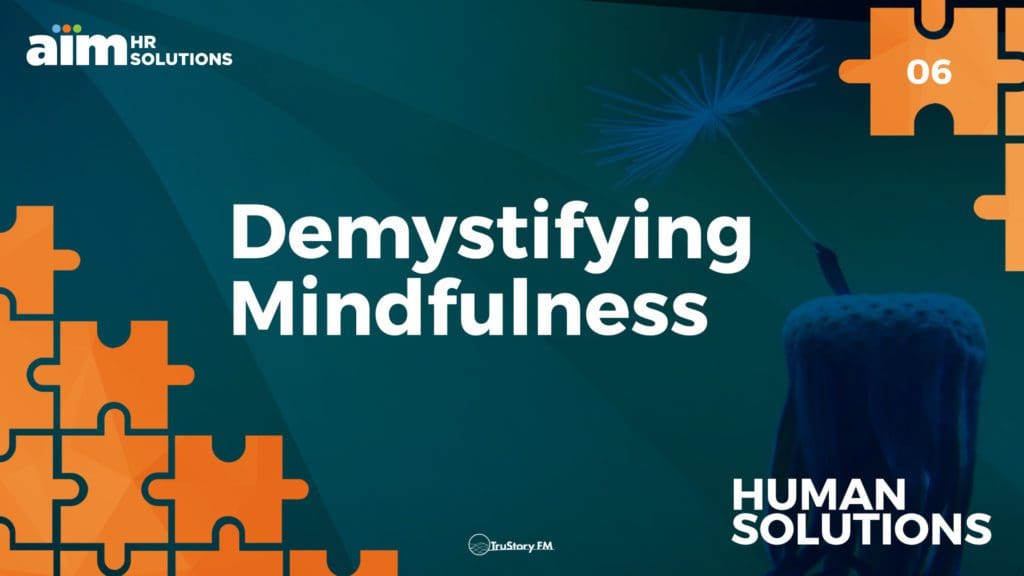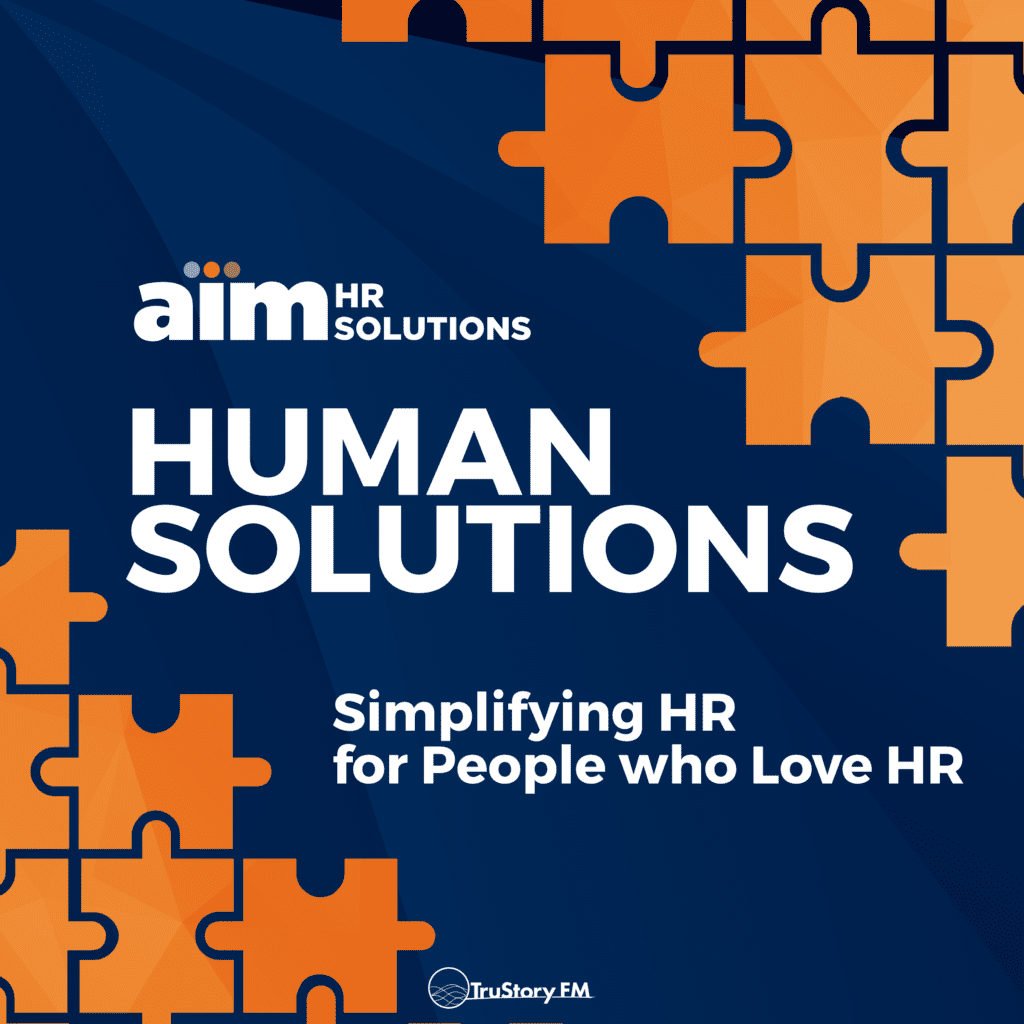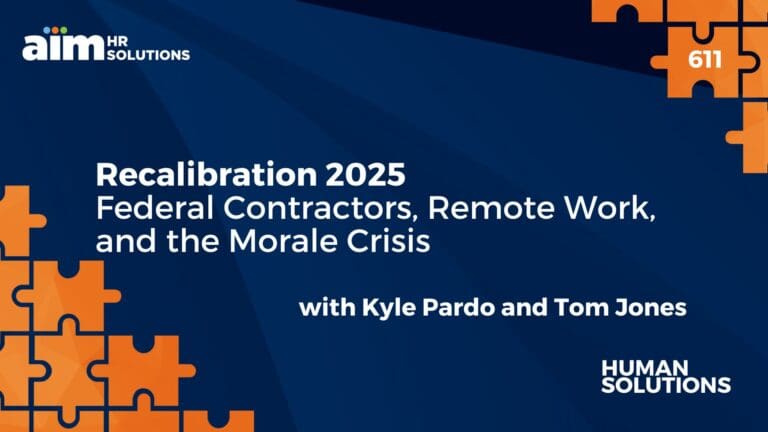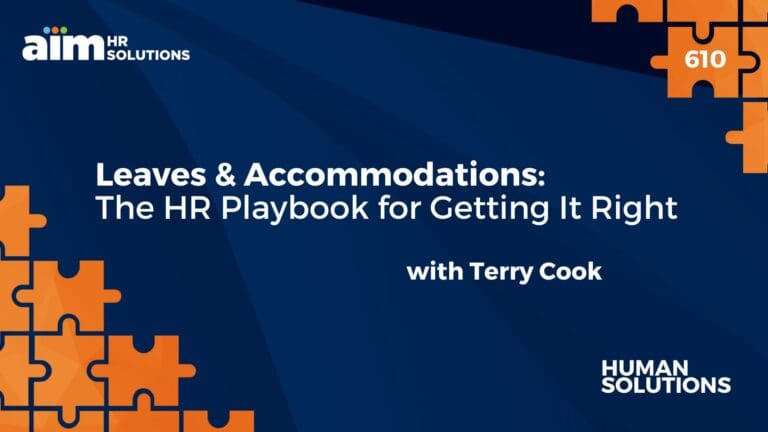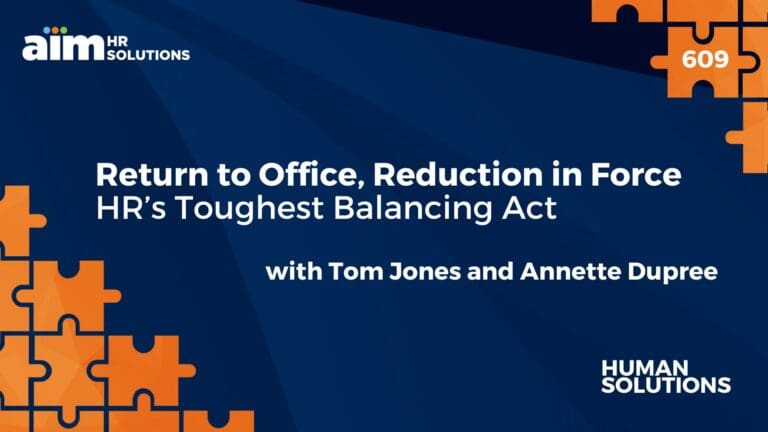Mindfulness has become a workplace buzzword, but what is it? Can you learn it? How do you practice it? Jen Moff and Kathleen Worthington join Pete Wright to delve into what HR and workplaces need to know about mindfulness, its benefits, and why you should care.
What is mindfulness? Jen and Kathleen each explore what it means to be in your body versus living in your head. Mindfulness is an experience of being, versus doing, living and working curiously. If you’re having trouble wrapping your head around the concept, listen on because the data is in: the benefits of mindfulness in the organization is compelling to be sure.
Whether you’re looking for a personal mindfulness practice or a way to further establish a culture of mindfulness across your organization, Jen and Kathleen have just the right guidance for you and your HR office!
Episode Transcript
Pete Wright: Welcome to Human Solutions, simplifying HR for people who love HR from AIM HR Solutions on TruStory FM. I’m Pete Wright. This week, we’re talking all about mindfulness. What does it mean to be mindful at work? Do you practice it? Can you learn it? As HR professionals, why should you be thinking about mindfulness at work in the first place? Kathleen Worthington, our Senior Director of Education and Workforce Training, and Jenn Moff, our VP of Learning and Development, join me to talk all about being mindful in and out of work and why you should care. Mindfulness, Jenn, Kathleen, thank you so much for sitting down with me today to have this conversation. Welcome back to the show, Jenn. Welcome Kathleen, first timer, great to have you here.
Jenn Moff: Yeah.
Kathleen Worthington: Thank you.
Pete Wright: Mindfulness, I guess we should start. Is it more than a buzzword, Jenn?
Jenn Moff: Yeah, you know-
Pete Wright: I heard you being mindful just then. That long exhale-
Jenn Moff: It’s cleansing breath.
Pete Wright: That was so centering, cleansing breath.
Jenn Moff: You’re so generous, Pete. You’re so generous to me. Is it more than a buzzword? I think that depends on the person, their answer. I’m sure there are people listening that do think, "All right. Let’s tune in and see if this really. I bet this is just the same thing that I think it is." I’m not here to change anybody’s mind by any means, but I personally don’t think of it that way. It exists on a spectrum like many things do. A buzzword definitely comes from trends in the zeitgeist if you will. Right now, mindfulness is very, very trendy. So, I don’t blame you for asking.
Pete Wright: It is trendy. I think that the danger of the memification of mindfulness is that it obscures some of the intentionality of living mindfully and working mindfully. I think that’s largely where I’d like to get to with this conversation. From the perspective of HR professionals, why is it important that we have this conversation at all?
Jenn Moff: Well, you make a good point, Pete. Something I want to touch on very quickly is a lot of times, I’ve heard people assume that to be mindful is the same thing as to be intentional. Yes, there is that definition out there but what we’re talking about here with demystifying mindfulness is not about necessarily intentional living exclusively. Is that a part of it? Yes. Mindfulness as a whole, there’s a number of definitions. I’ll just dive right in. If you’re ready to hear the def, I’m ready to give it.
Pete Wright: Ready to abbreviate words like definition for sure.
Jenn Moff: I know. I’m here all day, anyway.
Pete Wright: All day.
Jenn Moff: At least for the next 20 or so minutes. So to me, mindfulness is kind of a three-part thing. It’s the non-judgmental awareness of the present moment. So, let’s break that down. Non-judgment, so that means we aren’t labeling something as good, bad, right, or wrong. That’s in and of itself hard to do. The human brain likes to classify things and put things in boxes. We stay in a place of neutrality about things that we’re coming in contact with. Then, awareness just means we’re present to something. We are not ignoring it. We’re not putting our little blinders on or grabbing our rose-colored glasses. We’re honestly aware. Then the third part, the present moment. Focusing on the now, which is really hard for the brain too. It naturally wants to vacillate between the past and the future, and those are places that we can get caught up in different emotional states of anxiety, or fear, or sadness, or worry. In the present, there is peace. So, those three things are what make up mindfulness to me.
Kathleen Worthington: During a state of mindfulness, you’re going to notice your thoughts. You’re going to notice your feelings and even physical sensation. The body is involved as they happen. You’re not zeroing in like, "All right. Now, I’m going to think about what’s going on in my nose, or my ear, or my hands," but you’re aware. There is this awareness that Jennifer, she just said. The goal isn’t to clear your mind or stop thinking about it. It’s just to be, and to be aware of your thoughts and feelings rather than kind of getting lost, and spinning in them, and not doing. You just let it free. Just be, let it be.
Pete Wright: Let’s talk about the data behind the value in a mindfulness practice. Is there a recognized measured benefit?
Jenn Moff: Oh, goodness.
Kathleen Worthington: I have a little list I brought from Jon Kabat-Zinn. He is actually a leader in the field of mindfulness and health. He says, one, reduce symptoms of depression and anxiety. Two, improved memory focus and mental processing speed. Three, improved ability to adapt to stressful situations. Four, greater satisfaction within relationships. Two more, reduction of rumination. I don’t know about you, but that spinning, spinning repetitive, going through those scripts over and over in your mind. Then finally, improved ability to manage our emotions. That’s a great amazing list. Even if you got one right, if you’re able to conquer one, that would be a good beginning.
Pete Wright: I didn’t know it was a test, but now I realize that I’m aggressively trying to meet all of those characteristics.
Jenn Moff: Pete, there will be a pop quiz at the end and Kathleen is ready to administer it.
Pete Wright: She’s ready to administer. Well, what you’re describing there, and I think that gets to why we’re having this conversation too. That there is a sense of just measured anxiety in the world right now, right?
Jenn Moff: Mm-hmm.
Pete Wright: All of those things you could characterize as going through in times of stress and high pressure at work. Add on to that, the fact that the world is in a crazy state right now. There just seems to be more pressure than we have experienced in the past. Dealing with those things that come with the bouquet of anxiety, the perseverative thought spirals, these kinds of things that can really get in the way of your intended performance at work and thereby again at home. It seems like all of these things, there is some real benefit to just being aware of this practice.
Jenn Moff: This has been something I was introduced to back in 2011 or ’12. I was going through it, Pete. I was going through it.
Pete Wright: The documentary be released in 2023, the Jenn Moff story.
Jenn Moff: I’ll be on Netflix with my own show, talking all about it.
Pete Wright: Hey, Inventing Jenn.
Jenn Moff: So, a colleague of mine actually shared with me, "Jenn, you need to be more mindful." I’d never heard that word before, not once. I was like, "Woo," like the record scratch. I just kind of paused and I was like, "Mindful?" The way I described it, it’s like I must have been like a caveman that had just seen fire for the first time. It was such a powerful experience for me. I started reading so many wonderful books on the subject. It was incredibly transformative for me to have a sense of empowerment over my life and my thought processes and helped me hone that muscle to be able to not buy into what that monkey mind rumination that Kathleen was talking about a moment ago wanted to tell me about myself, or what I was capable of, or what a conversation with someone else meant. It was incredibly transformative for my life and me at work.
Kathleen Worthington: My first experience with mindfulness was about, I heard the word mindful and I’m thinking, "Well, would they want us to have more in our minds, be full in our minds?" I’m like, "I don’t think I have any more room. I already have plenty going on in there." Then, they’re like, "No, no. Mindful …" Like Jenn said, I thought it had to do with being more intentional.
Pete Wright: Mm-hmm.
Kathleen Worthington: Mm-mm, no. I had to step back even further. Then it was just about noticing, and being present, and being, allowing myself to be aware and not be judging myself. It was a whole different … When I put that spin on it and started applying it day to day and holding myself accountable, not to judge but just starting to feel it, it made sense. It totally made sense. The mindful before was just, "Okay, let’s just see if we can pack more things in." That was not how it works.
Jenn Moff: Litter up that storage unit.
Pete Wright: Right. You’re getting to this central question and we’ll speak personally before we zoom back out to organizationally. How do you know for the two of you that you’re living within a mindful practice? Does it make your fingertips tingle?
Kathleen Worthington: It’s being aware that your fingertips are tingling, that your blood is rushing when you’re anxious, or you’re in a moment. You’re having a moment and you feel that electricity. You know that current that can go up and down your arms and you feel your anxiety increasing? It’s being aware for me, at least being aware and then grounding. I do a little body scan. I can start and feel my feet and my toes and be aware of sensations that are going on. So for me, it’s just like paying attention a little more to myself.
Pete Wright: Curiosity, being curious, that practice of upasana. I stubbed my toe. What does it really feel like? Does it hurt? Am I just responding to it or do I really understand what that’s causing me right now? Jenn, what’s your experience?
Jenn Moff: I think back to when I wasn’t, to compare and contrast like, "Okay. I know the person that I am now." If I think back to who I was in say 2010, I was living a very reactive life. I felt trapped. I felt stressed out a lot. I did not feel empowered. I didn’t know why I was behaving in certain ways. I didn’t know if this was just the way life was. I didn’t have any concept of how things could be different until I was exposed to it. When I began a formal mindfulness practice, which is through meditation and just focusing on observing your breath, because it acts as an anchor to the present moment, it hones a muscle in the mind just like doing bicep curls or something, or pushups. That muscle that’s honed in the mind builds up the strength of you as an observer. So, you have separated yourself from your thoughts because you now can witness these thoughts. So instead of being reactive to life, a victim to life, you become empowered. You get to choose how you relate to people. You get to choose how you relate to yourself. You get to choose how you observe what’s going on in your own body, instead of just saying like, "Oh, I hurt my arm, man." It’s, "Okay. I feel that, that hurts. It does not feel good. I’m not happy. I might cry about it." I broke my toe last December and I consciously felt the pain and I was like, "I need to cry to let this out." That’s okay. I didn’t judge myself, and I released that. The benefit of doing these things is because having an adaptive stress reduction technique like mindfulness in both the formal meditative practice and an informal, just kind of more passive observation style, it helps us a way to manage your stress levels. As you started to allude to, work is not the most stress-free environment for many, many, many of us.
Pete Wright: Well, and that’s what I want to get to next. This is the why should I care part of the show, where we just ask that question because I think it’s really important to note as HR leaders, HR professionals that people are bringing a lot of pain with them all the time in all kinds of different packages. They’re showing up at work, and they’re doing the work of your organization carrying around this experience. So I come to you and ask, what is it that we’re asking HR professionals to be aware of as they come to work every day about the state of their team, and what can they do about helping it feel like a safer place to get work done?
Kathleen Worthington: So, people are watching. They’re watching us. They hold us to a special standard and really model the right behaviors day to day. So knowing how we’re showing up, because we’re always humans first, employees second, right?
Jenn Moff: Mm-hmm, yes.
Kathleen Worthington: So being in touch with ourselves and being aware as these situations come at us, how we’re responding, and how our body and our minds are responding, and being able to be aware and in touch. Then I say, we’re sharing that with other leaders across the organization so that they too are aware of how they are showing up and modeling the right behaviors and being human first. Oftentimes leaders hold themselves to a very high standard that they can’t allow their emotions to be out, be put out there. That’s absolutely not true at all. If anything, leaders should be showing that it’s okay for us to not always know the answers, to have feelings, to be stressed, to not have the answer to the problem in the moment because then that gives their employees permission to also be able to do the same. We become more psychologically safe at work. I could start off on another tangent here, but really truly being able to allow leaders to be, be aware, and also to tune into their empathy within their own being and sharing themselves in a new way to their people, really helps them connect.
Pete Wright: This goes to the next part of the question, which is what is the role in HR and particularly training and development to help create a culture that embraces and extends an organizational practice of mindfulness. Is there a role for that?
Jenn Moff: I personally think, yes. Kathleen agrees.
Kathleen Worthington: I think it starts with the leadership, right from the top. HR is going to be a business partner at their table and show them because often they’re very hardwired to care about that bottom line and return on investment. They’re very focused on the business. Of course they should, but this is the people side of the business. So, they’re going to be coaches. They’re going to be guiding and being partners with their leaders.
Jenn Moff: I know that, and I don’t have as much experience in HR. I’m a learning and development professional, and coach, and speaker by trade. I have a relative that actually got into HR decades ago before there was any kind of formalized process around working in it. It was before they had a degree program for it. So she naturally ended up in this position, and she ended up getting forced out when the evolution of the industry asked more of candidates. So, this has just been in the last 50 years. There’s been so much change in the HR industry. So to me, this idea of focusing on and valuing wellbeing in the workplace and some capacity and mindfulness exists under that umbrella is part of the new wave of what we need our culture and our HR professionals to support, embody, and promote internally. That’s the evolution of business. That’s all I can see from an outsider and from somebody partnering peripherally.
Kathleen Worthington: I agree with Jenn completely. They can’t do it alone though. HR cannot drive it alone. It really has to be a partnership with the leadership team across the board and be part of their organizational values. Wellness, really valuing employee wellness and building it into their culture. What their brand is, what matters most to them?
Jenn Moff: You make a great point, Kathleen. Someone sent me an email the other day with an article about how gen Z and millennials actually feel that a lot of their employers. I think this was around the 30, 40, 50 percentage give wellbeing lip service like, "Oh yeah, we care about this, shooks." Then the behaviors don’t match the words.
Pete Wright: There you go.
Jenn Moff: So to what Kathleen was saying is like, it has to start at the top. It has to be something that the CEO, the C-suite, the HR team, everybody has to value this in order for it to work as a holistic unit and benefit everyone.
Kathleen Worthington: There you go. Otherwise, it’s just another flavor of the month. Another program that HR is running, instead of baking it into the culture of the organization.
Pete Wright: Well, this gets to something we have talked about before which is this idea of, if it is baked into a program. Let’s say mindfulness is somehow built into your health package, right?
Kathleen Worthington: Mm-hmm.
Pete Wright: You get some hours of whatever. You get to go to therapy. You get to do … It’s all built into the package. Therefore, I guess we don’t have to do anything internally because we’ve applied a policy that allows us not to have to think about it. If you need it, you go get it but we don’t have to do anything for you at work in meetings and the way we structure our days. You have perspective on that?
Jenn Moff: I do.
Kathleen Worthington: I do too.
Pete Wright: I was hoping.
Jenn Moff: Were, you know, Pete.
Pete Wright: I wasn’t fishing, but I like what I caught. Go ahead.
Jenn Moff: Snaps. I think that what you’re talking about happens, and I think it’s probably part of the evolution of the conversation. "It’s low hanging fruit, so to speak." It’s easier for companies who are trying to buy into this, or jump on the train, or ride the bus, but it’s not a magic pill. It’s not the thing that’s going to fix everything. It’s a piece of a much bigger puzzle that has to be put together.
Kathleen Worthington: It’s not a check in the box. It’s check in the box. How long is that going to last? We know that. We’re transparent when we see those check in the box. It’s really about sustaining it. So yes, we can have access to it through EAP, Employee Assistance Program, or you’re learning a development team rolls out a lunch and learn series, or some series of workshops, but how do we sustain it? It’s about then defining the behaviors. What does it look like? Giving people permission to practice, to use the language, to use the vocabulary, to not have it be just the flavor of the month but have it be just part of who we are as an organization and what we value.
Pete Wright: As we get to wrapping up here, I want to make sure people walk away with some tangible direction. Where do we point HR professionals who really would like to put some muscle behind this? How do you start a program that helps bring this benefit to work?
Kathleen Worthington: Call us, AIM HR Solutions.
Pete Wright: That’s what I was hoping.
Kathleen Worthington: Come on, Jenn.
Pete Wright: I was waiting for the commercial, Kathleen.
Jenn Moff: Yes, Kathleen. Absolutely. We are here to partner with you in any way that you want support. We create customized bespoke solutions. I’m so happy to be a part of the organization now, because like Kathleen mentioned, this is my bread and butter. I am very excited about the growth that we’ll be able to provide you and so many others as we continue to invest in wellbeing for all people at all companies.
Kathleen Worthington: I feel it’s just the right thing to do right now. Right now, what a couple years we’ve had and who knows what’s around the corner? So there’s nothing better than taking care of ourselves, taking care of our employees.
Pete Wright: We can’t lose the focus that our organizations, whether we’re working in the same building, whether we’re working in the same cubicle farm, whether we’re working in our home offices completely separate from one another. The organization is a living, breathing organism. It needs care and feeding.
Kathleen Worthington: It absolutely does.
Pete Wright: This is a great way to do that. So thank you, both Kathleen Worthington and Jenn Moff. You guys are fantastic. Thank you.
Kathleen Worthington: Thank you, Pete.
Jenn Moff: Thank you, Pete. It was fun.
Pete Wright: Thank you everybody for downloading and listening to this show. We sure appreciate you. As always, you can find links and notes about the show at aimhrsolutions.com. You can listen to the show right there on the website or subscribe to the show in Apple podcasts or Spotify, anywhere your favorite podcasts are served. On behalf of Kathleen and Jenn, I’m Pete Wright. We’ll catch you next week right here on Human Solutions, simplifying HR for people who love HR.







